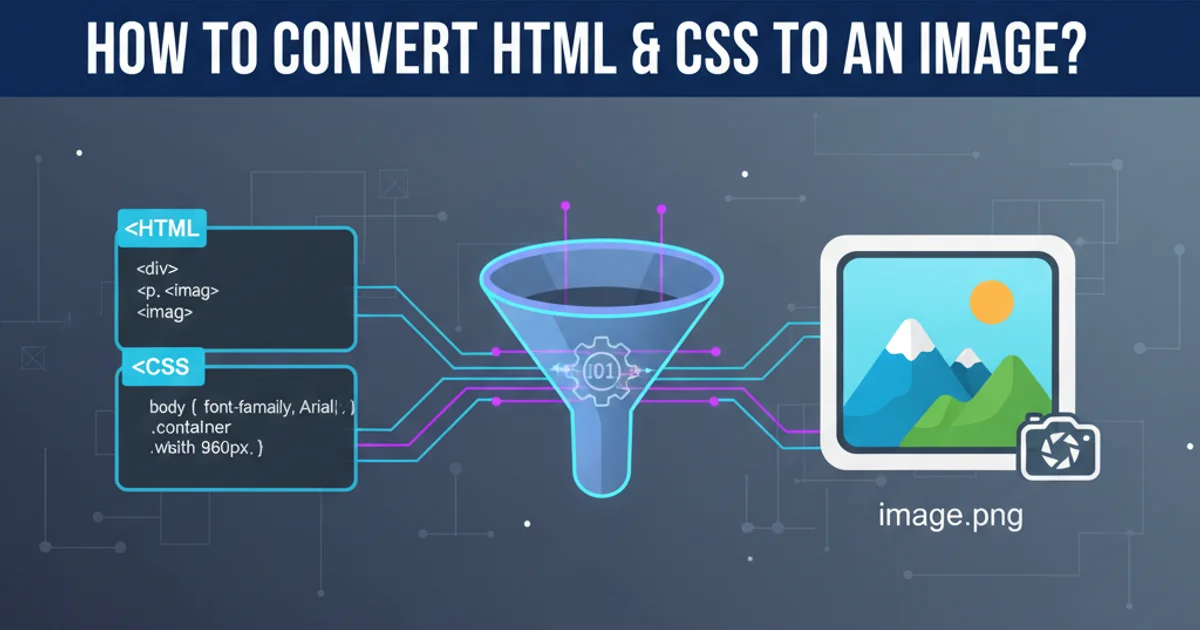How to convert html & css to an image?
Categories:
Converting HTML & CSS to Images: A Comprehensive Guide

Learn various methods to render HTML and CSS content into static image files, exploring server-side and client-side solutions for web scraping, archiving, and dynamic content generation.
Converting HTML and CSS into an image is a common requirement in web development. This process can be crucial for various applications, such as generating social media share images, creating PDF reports, archiving web pages, or even for dynamic content generation where a static visual representation is needed. This article will explore different approaches, focusing on both client-side (browser-based) and server-side solutions, with practical examples and considerations.
Understanding the Challenge: Rendering Web Content
The core challenge in converting HTML/CSS to an image lies in accurately rendering the web content. Browsers are designed to interpret and display HTML, apply CSS styles, and execute JavaScript. To convert this dynamic, interactive content into a static image, a rendering engine is required that can simulate a browser's behavior and then capture the visual output. This process involves layout calculation, style application, and pixel rendering, much like what a browser does.
flowchart TD
A[HTML/CSS Input] --> B{Rendering Engine}
B --> C[Layout & Styling]
C --> D[Pixel Generation]
D --> E[Image Output (PNG/JPEG)]
B -- Optional --> F[JavaScript Execution]
F --> CHigh-level process of converting HTML/CSS to an image
Client-Side Conversion using JavaScript and Canvas
Client-side conversion typically involves using JavaScript libraries that leverage the browser's rendering capabilities. The most popular approach uses the HTML canvas element to draw the rendered HTML content. Libraries like html2canvas simplify this process significantly. This method is excellent for scenarios where the conversion happens directly in the user's browser, without needing server interaction.
<!DOCTYPE html>
<html>
<head>
<title>HTML to Image</title>
<style>
body { font-family: Arial, sans-serif; margin: 20px; }
#contentToCapture { border: 1px solid #ccc; padding: 20px; background-color: #f9f9f9; }
h1 { color: #333; }
p { color: #666; }
</style>
</head>
<body>
<div id="contentToCapture">
<h1>Hello from HTML!</h1>
<p>This is some content that will be converted into an image.</p>
<p>It includes <strong>bold text</strong> and <em>italic text</em>.</p>
</div>
<button id="captureButton">Capture as Image</button>
<div id="output"></div>
<script src="https://html2canvas.hertzen.com/dist/html2canvas.min.js"></script>
<script>
document.getElementById('captureButton').addEventListener('click', function() {
html2canvas(document.getElementById('contentToCapture')).then(function(canvas) {
// Append the canvas to the body or a specific div
document.getElementById('output').appendChild(canvas);
// Or get the image data URL
var imgData = canvas.toDataURL('image/png');
var img = new Image();
img.src = imgData;
document.getElementById('output').appendChild(img);
// You can also trigger a download
// var link = document.createElement('a');
// link.href = imgData;
// link.download = 'html-content.png';
// link.click();
});
});
</script>
</body>
</html>
Server-Side Conversion with Headless Browsers or Dedicated Libraries
For more robust and reliable conversions, especially when dealing with complex layouts, dynamic content, or cross-origin resources, server-side solutions are often preferred. These methods typically involve using a headless browser (like Puppeteer for Chrome or Playwright for various browsers) or dedicated libraries/APIs. Server-side conversion offers greater control and consistency, as it's not dependent on the client's browser environment.
<?php
// This example assumes you have Node.js and Puppeteer installed on your server
// and a script named 'capture.js' that uses Puppeteer.
// capture.js content (Node.js):
/*
const puppeteer = require('puppeteer');
(async () => {
const browser = await puppeteer.launch();
const page = await browser.newPage();
const htmlContent = process.argv[2]; // Get HTML from command line argument
const outputPath = process.argv[3]; // Get output path
await page.setContent(htmlContent, { waitUntil: 'networkidle0' });
await page.screenshot({ path: outputPath, fullPage: true });
await browser.close();
})();
*/
$html = '<h1>Server-Side Rendered!</h1><p style="color: blue;">This content was converted on the server.</p>';
$outputFile = 'output.png';
// Escape HTML for command line argument
$escapedHtml = escapeshellarg($html);
// Execute the Node.js script using Puppeteer
$command = "node capture.js {$escapedHtml} {$outputFile}";
$output = [];
$return_var = 0;
exec($command, $output, $return_var);
if ($return_var === 0) {
echo "Image '{$outputFile}' generated successfully.";
// You can then serve this image or embed it.
echo '<br><img src="' . $outputFile . '" alt="Generated Image">';
} else {
echo "Error generating image: " . implode("\n", $output);
}
?>
Choosing the Right Tool and Method
The best method depends on your specific use case:
- Client-side (
html2canvas): Best for simple, non-sensitive content, user-initiated screenshots, or when you want to offload processing from your server. It's easy to implement but has limitations with complex CSS, external resources, and cross-origin content. - Server-side (Headless Browsers like Puppeteer/Playwright): Ideal for high-fidelity rendering, complex pages, dynamic content, and when you need full control over the rendering environment. This is suitable for generating social media cards, PDF reports, or automated web page archiving.
- Dedicated APIs/Services: For those who don't want to manage server infrastructure, various cloud-based APIs offer HTML to image conversion as a service. These often provide robust features and scalability out of the box.
graph TD
A[Requirement] --> B{Client-side or Server-side?}
B -- Client-side --> C[Simple HTML/CSS]
C --> D[html2canvas.js]
B -- Server-side --> E[Complex Layouts / Dynamic Content]
E --> F[Headless Browser (Puppeteer/Playwright)]
E --> G[Dedicated API Service]
D --> H[Image Output]
F --> H
G --> HDecision tree for choosing HTML to image conversion method